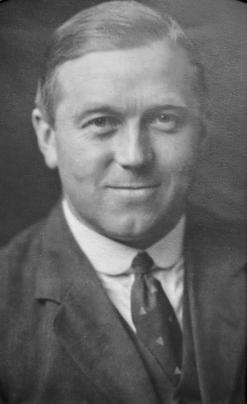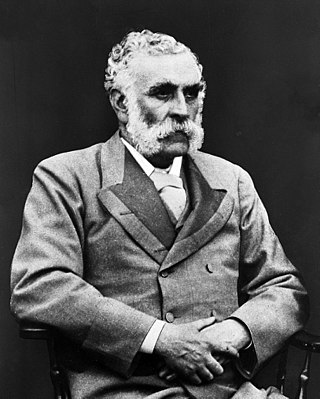
Sir John Fraser, 1st Baronet, was Regius Professor of Clinical Surgery at Edinburgh University from 1925 to 1944 and served as principal of the University of Edinburgh from 1944 to 1947.

Douglas Moray Cooper Lamb Argyll Robertson FRSE, FRCSEd LLD was a Scottish ophthalmologist and surgeon. He introduced physostigmine into ophthalmic practice and the Argyll Robertson pupil is named after him. He was president of the Royal College of Surgeons of Edinburgh.

Sir George Andreas Berry LLD, FRSE, FRCSEd was a Scottish ophthalmic surgeon who acquired a reputation as a leading authority on ophthalmology, not only in the United Kingdom but also in the United States and continental Europe. His standing in the profession was largely the result of his textbooks of ophthalmology which were widely used in his home country and abroad. His working career was spent at the Royal Infirmary of Edinburgh and when he retired from clinical practice in 1905 he became involved in medical and national politics. He was surgeon-oculist in Scotland to King George V and then to King Edward VII and was president of the Royal College of Surgeons of Edinburgh from 1910 to 1912. He was knighted in 1916. At the 1922 general election he was elected as Member of Parliament for the Combined Scottish Universities, sitting as a Scottish Unionist. He held the seat until he stood down at the 1931 general election.

John Chiene, CB, LLD, MD, FRSE, FRCSEd was a Scottish surgeon, who was Professor of Surgery at the University of Edinburgh during some of its most influential years. He was a founder of the Edinburgh Ambulance Service. The Chiene Medal is presented as an annual prize in surgery at the University. He served as President of the Royal College of Surgeons from 1897 to 1899.

David Maclagan MD, FRSE, FRCSEd, FRCPE was a prominent Scottish medical doctor and military surgeon, serving in the Napoleonic Wars. He served as President of both the Royal College of Physicians of Edinburgh and the Royal College of Surgeons of Edinburgh. He was Surgeon in Scotland to Queen Victoria.

James Haig FergusonLLD FRSE FRCPE FRCSEd was a prominent Scottish obstetrician and gynaecologist. He served as President of the Royal College of Surgeons of Edinburgh from 1929 to 1931 and was president of the Edinburgh Obstetrical Society. He chaired the Central Midwives Board of Scotland and was manager of Donaldson's School for the Deaf. In 1929 he was a founding member of the British College of Obstetricians and Gynaecologists.

Sir Henry Wade PRCSE FRSE DSO CMG was a Scottish military and urological surgeon. He was elected president of the Royal College of Surgeons of Edinburgh in 1935. His collection of anatomical specimens was donated to Surgeon's Hall in Edinburgh and is known as the Henry Wade Collection.
William Walker was a Scottish surgeon who specialised in ophthalmic surgery. He was Surgeon Oculist in Scotland to Queen Victoria and President of the Royal College of Surgeons of Edinburgh. He was a keen amateur photographer, whose calotypes were displayed in photography exhibitions.

Henry (Harry) Moss Traquair, FRSE, PRCSE was a Scottish ophthalmic surgeon who made important contributions to the science of perimetry and the use of visual field testing in the diagnosis of disease. He was President of the Royal College of Surgeons of Edinburgh in 1939/40 and President of the Ophthalmological Society of the United Kingdom.

Arthur Logan Turner FRCSEd FRSE LLD was a Scottish surgeon, who specialised in diseases of ear, nose and throat (ENT) and was one of the first surgeons to work at the purpose-built ENT Pavilion at the Royal Infirmary of Edinburgh. During his surgical career he published a series of clinical papers and wrote a textbook of ENT surgery which proved popular around the world and ran to several editions. After retiring from surgical practice he pursued his interest in the history of medicine writing a biography of his father and histories of the Royal Infirmary of Edinburgh and the University of Edinburgh. As his father had been before him, he was elected President of the Royal College of Surgeons of Edinburgh. His collection of pathological specimens was donated to Surgeon's Hall Museum in Edinburgh..

George Ian Scott CBE, FRSE, FRCSEd was a 20th-century Scottish ophthalmic surgeon who in 1954, became the first holder of the Forbes Chair of Ophthalmology at the University of Edinburgh. He specialised in neuro-ophthalmology, studies of the visual fields and diabetic retinopathy. He was President of the Royal College of Surgeons of Edinburgh from 1964 to 1967, Surgeon-Oculist to the Queen in Scotland from 1965 and president of the Ophthalmological Society of the United Kingdom from 1970 to 1972.

Arthur Henry Havens Sinclair MD FRSE FRCSEd LLD was a 20th-century Scottish ophthalmologist. He was a pioneer of quantitative perimetry, introducing this technique of visual field testing to Britain. Sinclair also introduced the operation of intracapsular extraction of the lens for cataract into the UK. He was President of the Ophthalmological Society of the United Kingdom from 1931 to 1933 and was President of the Royal College of Surgeons of Edinburgh from 1933 to 1935. He was Surgeon-Oculist to King George VI in Scotland.

Alexander Miles MD, LL.D, FRCSEd was a Scottish surgeon who worked at the Royal Infirmary of Edinburgh. He was known for the quality of his surgical teaching, for his role as a medical journal editor and as the author of popular surgical textbooks and books on surgical history. He was elected President of the Royal College of Surgeons of Edinburgh.
Graham Malcolm Wilson (1917–1977) was a Scottish physician, professor of medicine, and pioneer of clinical pharmacology.
John Henry WishartFRCSEdFRSE was a Scottish surgeon who worked at the Royal Infirmary of Edinburgh. Although a general surgeon, he developed a special interest in the diagnosis and treatment of eye disease. He translated into English three major works of the Italian anatomist and surgeon Antonio Scarpa. With John Argyll Robertson, Wishart jointly founded the Edinburgh Eye Dispensary. He was surgeon in Scotland to King George IV and served as President of the Royal College of Surgeons of Edinburgh from 1820 to 1822.

Walter Quarry Wood MD, ChM, FRCSEd was a Scottish surgeon who became known as a collector of Scottish Colourists. He worked at the Royal Infirmary of Edinburgh (RIE) and was president of the Royal College of Surgeons of Edinburgh.

James Dunsmure FRCSEd was a Scottish physician and obstetrician who, as his father had done before him, served as President of the Royal College of Surgeons of Edinburgh.
Lieutenant-Colonel Herbert Herbert, FRCS was a British ophthalmologist and officer in the Indian Medical Service (IMS), known for his work on trachoma, cataract and glaucoma. Later, he was vice-president of the Ophthalmological Society of the UK.














